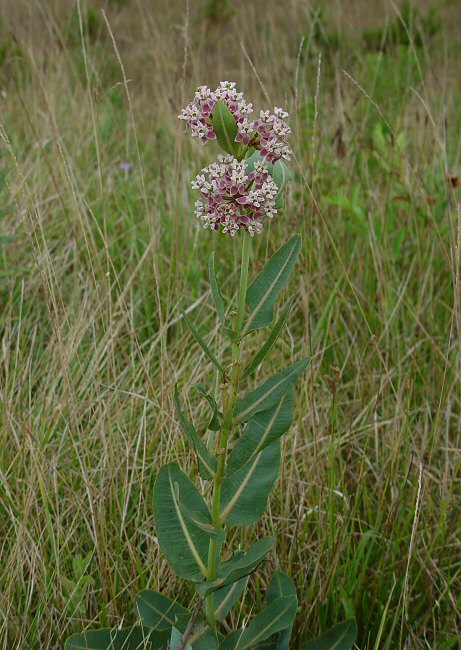Asclepias sullivantii Engelm. ex A. Gray
Smooth Milkweed

Native
CC = 8
CW = 5
MOC = 27
© DETenaglia
Asclepias sullivantii Engelm. ex A. GraySmooth Milkweed | |
 |
Native CC = 8 CW = 5 MOC = 27 |
© DETenaglia |
|
Family - Asclepiadaceae Habit - Perennial forb with deep rhizomes, often colonial. Stems - Ascending to erect, to 1.1 m, glabrous, often glaucous, stout, usually unbranched below the inflorescence, with milky sap, with 7-15 nodes.
Leaves - Opposite, sessile, simple, glabrous, entire, to 16 cm long, to 9 cm broad, lanceolate to oblong, green above, glaucous-blue below, rounded or truncate at the base, blunt to rounded at the tip but with a small, triangular mucro. Midrib whitish and clearly differentiated from the other leaf tissues. Veins anastomosing near the leaf margin.
Inflorescence - Pedunculate umbels, terminal and from the upper leaf axils, with 15-40 flowers. Peduncles to 4-5 cm long, glabrous, green. Rays of the umbel subtended by small lanceolate bracts. Bracts to 5 mm long, acute, glabrous. Rays (pedicels) purplish, 2 cm long, glabrous.
Flowers - Calyx lobes 5, reflexed, glabrous, 4-6 mm long, lanceolate to ovate. Corolla lobes 5, reflexed, glabrous, pink to purplish-pink, sometimes tinged with green, 9-12 mm long, lanceolate to oblong-lanceolate. Gynostegium appearing sessile or very short-stalked (the column sometimes barely visible below the bases of the hoods), pink, the corona conspicuously longer than the tip of the anther/stigma head. Corona hoods 5.0-6.5 mm long, loosely ascending to ascending, attached near their bases, oblong to oblong-ovate in outline, the tip rounded to broadly rounded, the margins not toothed, with a pair of small, pouched areas near the base. Horns attached toward the hood bases, relatively short, bent or curved abruptly inward over the anther/stigma head and not extended past the tips of the hoods, sickle-shaped, relatively stout, slightly flattened, tapered to a sharp point at the tip. Anther column to 5 mm long, 4 mm in diameter. Pollinia 3 mm long. Terminator 0.8 mm long, deep purple. Anther sacs 2 mm long.
Fruits - Follicles 8-10 cm long, erect or ascending from deflexed stalks, narrowly ovate to ovate and slightly arched in outline, the surface with small, warty, spinelike tubercles above the middle, glabrous or minutely hairy. Seeds with the body 7-8 mm long, the margins narrowly or relatively broadly winged, the terminal tuft of hairs white.
Flowering - June - July. Habitat - Prairies, river bottoms, pond margins, forest openings, alluvial thickets. Origin - Native to the U.S. and Canada. Lookalikes - A. syriaca. Other info. - This attractive species of milkweed can be found mainly in the northern half of Missouri, though it is not particularly common in the state. Its North American range includes the U.S. Midwest and extends into Canada. Of the milkweeds occurring in Missouri, this plant most closely resembles the common milkweed, A. syriaca; however, in contrast to that species, A. sullivantii has completely glabrous parts, and larger flowers which are also fewer in number. A. syriaca is also typically taller than A. sullivantii and has hairy stems and leaves. Photographs taken off Hwy 70, Callaway County, MO., 8-12-06 (DETenaglia); also at Shaw Nature Reserve, Franklin County, MO, 7-9-2012 and 7-2-2017 (SRTurner) and 8-4-2018 (KBildner). |